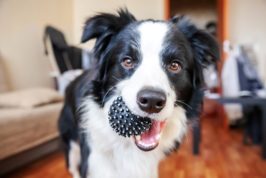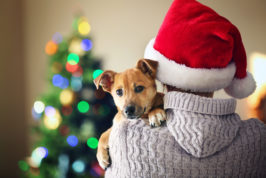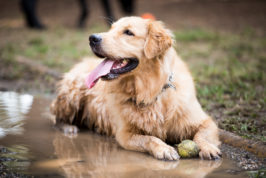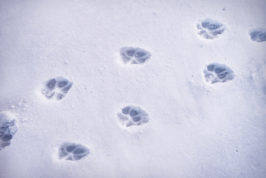All you need to know about cruciate ligaments in dogs
Cruciate ligaments are small, but they’re a major source of problems for dogs, and the most common to cause issues in the canine knee joint. Dr Joanna Woodnutt explains just why cruciate ligaments are so problematic…
What is the cruciate ligament?
Inside your dog’s knee – medically termed the ‘stifle’ – the thigh bone (femur) and shin bone (tibia) meet in a joint. The cruciate ligaments are a pair of tough elasticated bands that sit inside each knee, and cross over one another inside the joint – hence the term cruciate, meaning cross.
The front-most cruciate ligament is called the cranial cruciate ligament in animals – but you may also hear it called the anterior cruciate ligament, which is a term borrowed from human medicine. This is the one that tends to cause all the trouble. It stretches from the back of the femur, through the joint, and attaches onto the front of the tibia.
The posterior cruciate ligament doesn’t often get damaged. It stretches from the front of the femur, through the joint, and attaches onto the back of the tibia.
The cruciate ligaments work together to prevent the femur from sliding across the top of the tibia when weight is placed through the joint.
What sort of problems can arise with the cruciate ligaments?
The cranial cruciate ligament is prone to tear or rupture. When this happens, it’s no longer able to support the joint. So when your dog puts weight through their leg, the femur slides forwards across the surface of the tibia. This is uncomfortable, and many dogs will instantly become lame with a cruciate tear.
This movement often damages the meniscus (a cushion-like structure inside the joint), and stretches the joint capsule (the layer that surrounds the joint). Over time, the excessive movement will also damage other joint structures, leading to Arthritis.
Partial cruciate tears also occur, but are harder to diagnose. Dogs suffering from this are uncomfortable, with only small amounts of abnormal movement in their knee. This is likely to cause on-off mild lameness.
What causes cruciate ligament problems in dogs?
The causes of cruciate ligament problems are complex and poorly understood. In most dogs, several of the following causes increase their risk of developing a cranial cruciate ligament tear:
Genetics
Although all breeds suffer with cruciate problems, some breeds are more likely to rupture their cruciate than others. The five most commonly affected breeds are the Newfoundland, Rottweiler, Labrador Retriever, Bulldog and Boxer. However, this isn’t just a condition of large dog breeds – the West Highland White Terrier and Yorkshire Terrier are also more likely to have cruciate problems than the average dog.
Age and neuter status
Large breeds are more likely to get cruciate problems after five years of age. Smaller breeds tend to be a bit older, with an average age of seven years old.
Neutering at less than 12 months of age has been shown to increase the risk of cruciate ligament tears in Rottweilers, but otherwise, neuter status doesn’t seem to have any impact on cruciate disease.
Nutrition and weight
Obesity is also linked with a higher chance of developing cranial cruciate ligament problems. Whilst this could be because of the above-normal weight on the joint, it may also be because fat cells release pro-inflammatory messages, increasing inflammation in many parts of the body.
There have been no links made between feeding practices and the risk of cruciate rupture. However, nutrient imbalance can cause growth deformities that increase the risk of joint and bone problems.
Exercise
It’s thought that inactivity may predispose joints to damage – regular, consistent exercise is much better. However, cruciate ligaments often rupture during intense exercise, especially jumping and twisting, so it’s important to be aware of the type of exercise you’re doing with your dog.
Other conditions
About 40% of dogs with Patella Luxation (an out-of-place kneecap) will also have cruciate ligament rupture. This is because the inherent instability in the knee puts extra strain on the cruciate ligament.
One study also identified a link between Hip Dysplasia and cruciate ligament rupture. In the study, about a third of dogs with Hindlimb Lameness thought to be due to Hip Dysplasia were actually found to have cruciate ligament rupture instead.

How can I protect my dog’s cruciate joint?
If you own an at-risk breed, it’s understandable that you want to try to protect their knees as much as possible. Luckily, there are some things you can do that may help…
- Ask your vet what your dog’s ideal adult weight is, and try to keep them there
- If you own a Rottweiler, have a discussion with your vet about the best age to neuter them
- Exercise your dog every day
- Warm up before exercise – don’t just open the car boot and let them charge off
- Avoid intense jumping and twisting games – in my experience, most dogs injure their ligaments in the garden, playing
- Feed your dog a complete and balanced diet, to make sure they have the correct nutrients
- Consider adding joint supplements from a young age to support joint health and repair
- Provide rubber-backed, non-slip mats on hard surfaces to prevent slips that over-stretch the ligaments
However, it’s important to understand that – even if you do all of these things – the cruciate can still tear. We don’t know all the causes and risks for cruciate ligament problems in dogs, so we can’t prevent every case. If your dog does develop a cruciate ligament tear, remember it’s not your fault. You can read about how to help your dog if they develop a torn cruciate here.
Conclusion
Despite its tiny size, the cruciate ligament is damaged in about 1 in 200 dogs, and is one of the most common causes of Hindlimb Lameness in dogs. The causes are poorly understood, but there are some things you can do to reduce your dog’s risk of developing cruciate problems. However, there is always a risk that problems will occur, so be on the lookout and contact your vet if you’re concerned.




